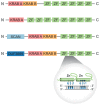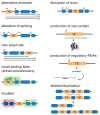KRAB zinc finger proteins
- PMID: 28765213
- PMCID: PMC7117961
- DOI: 10.1242/dev.132605
KRAB zinc finger proteins
Abstract
Krüppel-associated box domain zinc finger proteins (KRAB-ZFPs) are the largest family of transcriptional regulators in higher vertebrates. Characterized by an N-terminal KRAB domain and a C-terminal array of DNA-binding zinc fingers, they participate, together with their co-factor KAP1 (also known as TRIM28), in repression of sequences derived from transposable elements (TEs). Until recently, KRAB-ZFP/KAP1-mediated repression of TEs was thought to lead to irreversible silencing, and the evolutionary selection of KRAB-ZFPs was considered to be just the host component of an arms race against TEs. However, recent advances indicate that KRAB-ZFPs and their TE targets also partner up to establish species-specific regulatory networks. Here, we provide an overview of the KRAB-ZFP gene family, highlighting how its evolutionary history is linked to that of TEs, and how KRAB-ZFPs influence multiple aspects of development and physiology.
Keywords: Co-option; Endovirome; Gene regulation; KRAB-ZFP; Speciation; Transposable element.
© 2017. Published by The Company of Biologists Ltd.
Conflict of interest statement
Competing interestsThe authors declare no competing or financial interests.
Figures





References
-
- Ayarpadikannan S, Lee H-E, Han K, Kim H-S. Transposable element-driven transcript diversification and its relevance to genetic disorders. Gene. 2015;558:187–194. - PubMed
-
- Baudino L, Yoshinobu K, Morito N, Santiago-Raber ML, Izui S. Role of endogenous retroviruses in murine SLE. Autoimmun Rev. 2010;10:27–34. - PubMed
Publication types
MeSH terms
Substances
Grants and funding
LinkOut - more resources
Full Text Sources
Other Literature Sources
Miscellaneous

